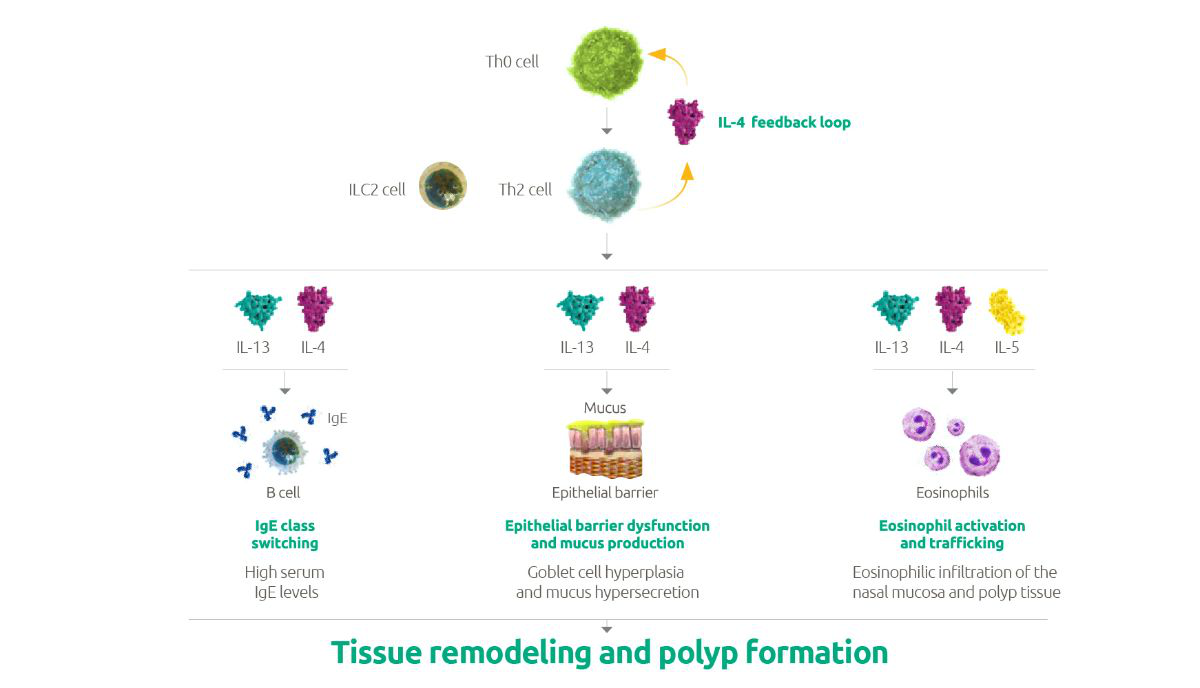{
event: "article_read",
name: `About Type 2 Inflammation – Nasal Polyps`,
author: ``,
tags: `Nasal Polyps`,
publication_date: ``,
interaction_type: "content"
}
About Type 2 Inflammation – Nasal Polyps
Type 2 Inflammation in Chronic Rhinosinusitis with Nasal Polypolis (CRSwNP)
CRSwNP is a Chronic Type 2 Inflammatory disease with high symptom burden and substantial unmet need
CRSwNP patients experience high symptom burden and have a reduced health-related QoL²
Nasal Symptoms
- Congestion
- Sneezing
- Loss of smell/taste
- Runny nose
- Nasal discharge
Ear and Facial Symptoms
- Facial pain
- Facial pressure
- Ear pain
- Ear pressure
- Dizziness
Health-Related QoL Impact
- Difficulty falling/staying asleep
- Fatigue
- Waking up tired
- Reduced concentration
- Reduced productivity
Psychological Symptoms
- Frustration, restlessness, irritability
- Sadness
- Embarrassment
- Abdalla S, Alreefy H, Hopkins C. Prevalence of sinonasal outcome test (SNOT-22) symptoms in patients undergoing surgery for chronic rhinosinusitis in the England and Wales National prospective audit. Clin Otolaryngol. 2012;37(4):276-282.
CRSwNP patients often have coexisting Type 2 Inflammatory disease1,2
- 50% Asthma
- 75% Allergic Rhinitis
- 10-20% NSAID-ERD
NSAID-ERD, nonsteroidal anti-inflammatory drug–exacerbated respiratory disease; QoL, quality of life.
- Khan A, Vandeplas G, Huynh TMT, et al. The Global Allergy and Asthma European Network (GALEN rhinosinusitis cohort: a large European cross-sectional study of chronic rhinosinusitis patients with and without nasal polyps. Rhinology. 2019;57(1):32-42.
- White AA, Stevenson DD. Aspirin-exacerbated respiratory disease. N Engl J Med. 2018;379(11):1060-1070.
Conventional therapy, including steroid bursts and surgery, does not always provide long-term relief
- Treatment guidelines recommend cautious use of systemic steroids ⁵⁻⁹
- Systemic steroids are not recommended as chronic therapy because of the risk of serious adverse effects with long-term use
- Difficult-to-treat patients are often refractory to medical and surgical management ¹⁰
- 35% of patients experience polyp recurrence within 6 months of surgery
80% of patients with CRSwNP have type 2 inflammation, which contributed to symptoms and polyp formation7,a
ᵃIn Western countries
- Slavin RG, Spector SL, Bernstein IL. The diagnosis and management of sinusitis: a practice parameter update. J Allergy Clin Immunol. 2005;116(6 suppl):S13-S47.
- Fokkens WJ, Lund VJ, Mullol J, et al. European position paper on rhinosinusitis and nasal polyps 2012. Rhinology. 2012;50(23):1-298.
- Orlandi RR, Kingdom TT, Hwang PH, et al. International consensus statement on allergy and rhinology: rhinosinusitis. Int Forum Allergy Rhinol. 2016;6(suppl 1):S22-S209.
- Kaplan A. Canadian guidelines for chronic rhinosinusitis: clinical summary. Can Fam Physician. 2013;59(12):e528-e534.
- Alobid I, Antón E, Armengot M, et al. SEAIC-SEORL. Consensus Document on Nasal Polyposis. POLINA Project. J Investig Allergol Clin Immunol. 2011;21(suppl 1):1-58.
- DeConde AS, Mace JC, Levy JM, Rudmik L, Alt JA, Smith TL. Prevalence of polyp recurrence after endoscopic sinus surgery for chronic rhinosinusitis with nasal polyposis. Laryngoscope. 2017;127(3):550-555.
- Chaaban MR, Walsh EM, Woodworth BA. Epidemiology and differential diagnosis of nasal polyps. Am J Rhinol Allergy. 2013;27(6):473-478.
IL-4 and IL-13 are Key and Central Drivers of Type 2 Inflammation
IL-4 and IL-13 are central type 2 cytokines that have shared and distinct roles in the pathophysiology of CRSwNP1,2
ILC2, Type 2 Innate lymphoid cells
- Gandhi NA, Bennett BL, Graham NMH, Pirozzi G, Stahl N, Yancopoulos GD. Targeting key proximal drivers of type 2 inflammation in disease. Nat Rev Drug Discov. 2016;15(1):35-50.
- Schleimer RP. Immunopathogenesis of chronic rhinosinusitis and nasal polyposis. Annu Rev Pathol. 2017;12:331-357.
Related articles
MAT-AE-2100343/V1/June2021


.jpg/jcr:content/image%20(41).jpg)
